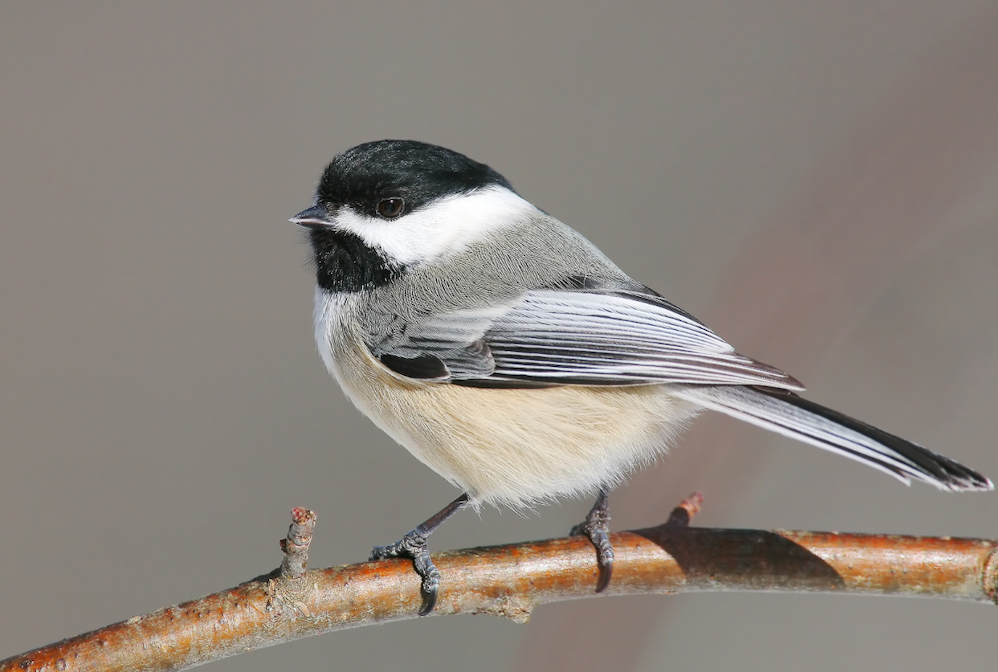Scientific Name:
– Family: Paridae
– Order: Passeriformes
Common Names
– Chickadees
Description
Chickadees are small, plump birds with a large head, short neck, and a tiny, sharp bill. They have a distinctive black cap and bib, with white cheeks, which are characteristic of the genus. Their underparts are typically soft buffy or pale gray, and their backs are grayish or brownish. Chickadees are highly active and acrobatic, often seen hanging upside down on branches as they forage. They range in size from about 4.5 to 6 inches in length, depending on the species.
Distribution and Habitat
Chickadees are found across North America, inhabiting a variety of forested environments, from dense coniferous and deciduous woods to suburban parks and gardens. They are non-migratory birds, generally staying within their breeding territories year-round.
Behavior
Known for their curious and friendly nature, chickadees are bold in the presence of humans and can often be coaxed to eat out of one’s hand. Their vocalizations include the familiar “chick-a-dee-dee-dee” call, from which their name derives, and a high-pitched “fee-bee” song. Chickadees are also known for their excellent spatial memory, which helps them relocate food caches during winter.
Diet
Chickadees primarily feed on insects, spiders, and other arthropods, supplemented by seeds and berries, particularly in colder weather. They are adept foragers, often joining mixed-species feeding flocks in the non-breeding season.
Reproductive Information
Chickadees are cavity nesters, using natural holes in trees or those excavated by woodpeckers, and sometimes adapting man-made nest boxes. They line their nests with moss, hair, and other soft materials. Typically, they lay 5 to 8 eggs, which are incubated by the female alone for about two weeks. The chicks are fed by both parents and fledge in another two weeks.
Conservation Status
Chickadees are generally common and widespread, classified as Least Concern by the IUCN, though habitat loss and climate change pose threats to some populations.
Ecological Role
As insectivores, chickadees play a significant role in controlling pest populations. Additionally, their habit of caching seeds contributes to forest regeneration.
Research and Observation
Research on chickadees has contributed significantly to understanding avian memory, social behavior, and the impacts of urbanization on bird populations.
Management Strategies
Conservation efforts for chickadees focus on preserving forest habitats and promoting the use of nest boxes in areas where natural cavities are scarce.
Subspecies of Chickadees in the Western United States
Mountain Chickadee (Poecile gambeli)
- Found in mountainous regions from the Rockies to the Sierra Nevada and Cascades. Distinguished by its white eyebrow stripe over a dark eye line, which sets it apart from other chickadees. Mountain Chickadees adapt to high-altitude coniferous forests where they can forage for insects hidden in the bark and consume conifer seeds.
Chestnut-backed Chickadee (Poecile rufescens)
- Primarily located along the Pacific Coast from Alaska to California. This subspecies is notable for its rich chestnut coloring on the flanks and back, contrasting with its dark cap and white cheeks. The Chestnut-backed Chickadee prefers dense, wet coniferous forests, where it finds ample insects and spiders.
California Chickadee (Poecile sclateri)
- Recently recognized as distinct from the Mountain Chickadee, the California Chickadee inhabits the coastal and foothill regions of California. Similar in appearance to the Mountain Chickadee but often with less pronounced facial markings and slightly different vocalizations, this bird frequents oak woodlands and mixed chaparral habitats.
Black-capped Chickadee (Poecile atricapillus)
- This familiar chickadee is characterized by its striking black cap and bib, contrasting with its white cheeks and grayish underparts. It is predominantly found across the northern United States and much of Canada. Adapting well to both wild and suburban habitats, the Black-capped Chickadee is a common sight at feeders and in backyard gardens, where it is beloved for its curious and sociable behavior. These birds are incredibly hardy, managing to survive in cold temperatures thanks to their ability to lower their body temperature during cold winter nights, a process known as regulated hypothermia. The Black-capped Chickadee’s diet is diverse, consisting of insects, seeds, and berries, and they are known for their remarkable spatial memory, which allows them to relocate food caches even under a thick blanket of snow. The species’ vocalizations are complex and include the familiar chickadee-dee-dee alarm call, where the number of dee notes can indicate the level of threat.
How to Attract Chickadees to Your Property
1. Provide Suitable Nesting Sites: Chickadees are cavity nesters, so providing nesting boxes can encourage them to settle in your area. Ensure the boxes are the right size, with a hole diameter of about 1 1/8 inches to suit small chickadees like the Black-capped and Carolina Chickadees. Place the boxes in a quiet area, shielded from harsh weather and predators.
2. Offer Quality Bird Food: Chickadees are particularly fond of sunflower seeds, suet, and peanuts. Offering these in feeders can attract them throughout the year. Tube feeders, hanging feeders, or platform feeders work well, but make sure they are cleaned regularly to prevent disease.
3. Plant Native Trees and Shrubs: Planting native vegetation such as conifers and deciduous trees provides natural food sources and shelter. Berry-producing shrubs and plants that host caterpillars and other insects are especially beneficial as they provide a natural diet for chickadees.
4. Create a Water Source: A clean, fresh water source is vital for attracting chickadees and other birds. A simple birdbath or a small, shallow fountain can provide drinking and bathing opportunities for these birds. Ensure the water is kept fresh and the bath is cleaned regularly to prevent the spread of diseases.
5. Keep the Environment Safe: Make your yard a safe haven for chickadees by keeping cats indoors and managing window reflections to reduce bird strikes. Also, avoid using pesticides and herbicides, which can kill the insects that chickadees feed on and potentially harm the birds themselves.
6. Maintain a Layered Landscape: Chickadees prefer environments that mimic natural settings. Having a mix of tree heights, shrubs, and ground cover can provide optimal foraging opportunities and protection from predators.
7. Support Winter Survival: During winter, when food sources are scarce, continue to provide suet and seed feeders. Chickadees have remarkable memory for places where they have previously found food, so consistent feeding can ensure their regular presence in your garden.
By implementing these strategies, you can enjoy the lively activities of chickadees in your garden, benefiting both the birds and your enjoyment of local wildlife.
Click “Buy a Nestbox” below to start making your property a suitable habitat for the Chickadee species in your area.


